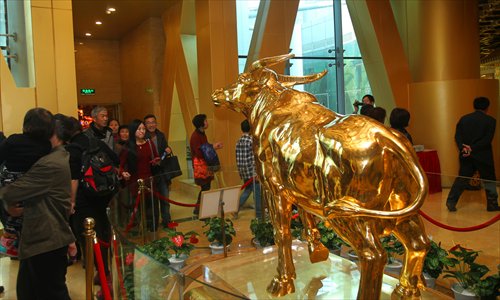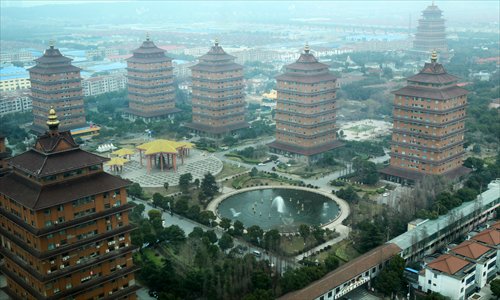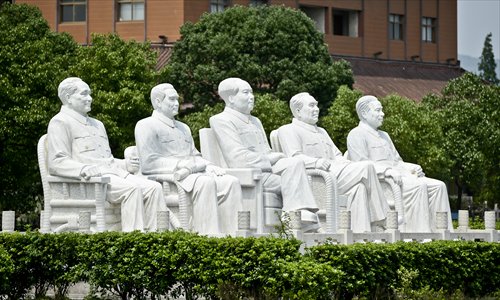China’s richest village manages to transition away from old industries
Huaxi, a village in East China's Jiangsu Province, is sailing through controversies and brushing off doubts over its socialist-style collective ownership by publishing a profitable balance sheet. The figures show that new industries like finance and shipping have become a major source of income for the village which is on track to transition away from traditional industries like steel and textiles manufacturing.

Visitors look at a statue of bull made of a ton of gold in Huaxi village. Photo: CFP
Huaxi Holdings Ltd, a listed company at Shenzhen Stock Exchange, published its annual report on January 13, in which it estimates that in 2015 its net profit increased by 40-50 percent year-on-year.
The majority of its shares are held by Huaxi Group, the Huaxi village enterprise.
The company's profits show that the village enterprise is on the way to transitioning away from traditional industries like steel and chemical fiber, its former key industries. New sectors including finance and shipping contributed to the surge of profit despite the stock market tumble in the latter half of 2015.
Huaxi has been touted as a model in bringing residents out of poverty and leading them to prosperity, and is reportedly the richest village in China.
Huaxi looks like no other village in the country. Its 328-meter-tall skyscraper looms over the village's neat rows of houses, its parks, its replica of the Arc de Triomphe and its monuments to Chairman Mao and other former Communist leaders.
Every year more than 2.5 million tourists flock to Huaxi to visit these spots, trying to discover the secrets behind its success.
The villagers' dividends are partly paid to them in cash and partly reinvested with the village enterprise, with the latter part exceeding millions of yuan for each household.
It has been nearly three years since the death of Wu Renbao, the "founding father" of Huaxi industries and secretary of the village for decades. Wu died in March 2013. Passing with him were the golden days of steel, chemical fiber and other declining traditional industries in China.
It was speculated that this village would decline with them, and small stakeholders had a lot to complain about during the shareholders conferences.
Wu Xie'en, Wu Renbao's youngest son, took over his father's posts in 2003 as both the village Party secretary and head of the Huaxi Group, though the senior Wu remained a significant figure behind the scenes.
Wu Xie'en was selected to the post over his three elder brothers by his father for being the "best qualified to make money."
The best moneymaker, Wu initiated a reform plan to shift the focus to finance, storage, and shipping. "The transformation has to be early and quick. It must begin when the situation is good and the enterprise has much room. It will be a different story if we are forced to change by the pressing situation and when the enterprise runs out of momentum," Wu Xie'en said at the time.
As of now, the steel mill and chemical fiber factories are being phased out of the village enterprise and marginalized, either being moved out or upgraded.
Figures show that during the first 10 months of 2015, the finance, shipping and tourism sectors of the Huaxi group contributed 65 percent of the group's profit, compared to the remaining 35 percent contributed by steelmaking, chemical fiber and textile manufacturing. This will be further reduced to below 30 percent of overall profit in three to five years' time, according to the village's plan.

A bird's eye view of Huaxi. Photo: CFP
Escaping steelmaking
The success of Huaxi's transformation lies in its quick transition away from steelmaking.
A power station at the southern end of the village square in Huaxi has been demolished, and a new cultural center is being built on the site.
On the other side of the village, rows of steel factories built in the 1980s and 90s have had the character chai (demolish) painted on their walls. Steel production is still going on in some factories but has been reduced to only one third of peak capacity, making nearly zero profit. The major reason that the steel mill is still operational is to keep up the employment rate.
Many workers in the mill are from "greater Huaxi," which means the 13 surrounding villages that merged with Huaxi in 2001. However, residents in "greater Huaxi" don't enjoy the same preferential policies that native Huaxi villagers enjoy, including socialist-style welfare from allocated housing to free education.
Huaxi rose to wealth thanks to traditional industries like steelmaking, chemical fibers and its power station. It took off with China's industrialization. In the first 20 years since China's opening up and reform began, steelmaking was the biggest industry in Huaxi, making up nearly half of the village's profit at its peak.
The decline of the steelmaking industry began in 2011, but as early as 2003 when the younger Wu became village secretary, Huaxi ceased to expand its steelmaking capacity and only invested in techniques to improve its products. It has invested 673 million yuan ($102 million) in new technology for its steel mills, power plants, chemical fiber and textile factories since 2003.
"The whole steelmaking industry is still declining, and 2016 is expected to be the worst year," said Huaxi Steel board director Yang Yongchang. Right now, the company only manufactures high-speed wires and screws and nuts and exports all its products to avoid the overcrowded domestic market. But still, the profitability of their steel mills has diminished in recent years and in 2015 the mills were barely covering their costs.
Sun Bin, general manager of the Huaxi Longxi Hotel, worked in the steel sector for nine years as a salesman. He said Huaxi successfully transformed itself thanks to its timely shift away from steel.
Since 2008, when steelmaking profit margins in China began to be squeezed, Huaxi closed nine enterprises in this sector. As a result, a number of managers started working in newer undertakings like hotels and shipping.

Sculptures of Mao Zedong, Zhou Enlai, Zhu De, Liu Shaoqi and Deng Xiaoping in Huaxi village. Photo: CFP
Rising new sectors
Of all the new undertakings of Huaxi, the financial sector has been the most profitable.
The listed company, Huaxi Holdings, mainly does chemical fiber trading and wharf storage, and in the meantime is a shareholder of four banks and securities companies. Huaxi's financial reports show that, thanks to the boom in the stock market, in the first half of 2015, the financial institutions contributed 43.98 million yuan, or 55.33 percent of Huaxi Holdings' profit, a 403.63 percent increase year on year.
However, after the stock market tumble since mid-2015, the stock price of Huaxi Holdings has fallen from 21.66 yuan per share to 7.82 yuan on Monday. But overall, the financial sector was still profitable last year.
Bao Lijun, deputy general mananer of Huaxi Group, said the high return from the financial sector was a result of Wu Xie'en's decisions more than a decade ago.
"Secretary Wu [Xie'en] asked me to acquire as many financial certificates as possible, and become stakeholders of those what we can't acquire," Bao said.
Since then, Huaxi has bought shares in five banks and two securities firms, and acquired certificates of a number of pawn shops and financial-services companies. As China struggles to shift from heavy industries to service and tertiary industries in the past couple years, Huaxi is ahead of the pack.
"In 2004 when I started investing in banks, few people were aware of it. When banks promoted their shares at the time, and some companies issued banking shares, I bought them all," Wu Xie'en told the Southern Weekly. It began in 2005 when other people realized the chance and began buying banking shares.
Figures issued by Huaxi show that its financial department with a staff of 320 people achieved its annual profit target of 101 million yuan in the first five months of 2015. At present, Huaxi makes money in finance mainly through dividends from shares, but it aims to include asset management and finance management in the future.
Besides finance, shipping is another major source of income for Huaxi. They became engaged in shipping through their steel businesses, as shipping makes up more than half of the price of iron ore, which Huaxi's steel mills bought at $200 per ton including freight before 2008.
However, a cargo ship with a capacity of 180,000 tons cost $150 million in 2007, out of the reach of Huaxi. Opportunities came in 2008 with the financial crisis, when steel prices plunged and ships were sold at only one third and even one fourth of their original price. The company began buying scrap ships to be dismantled for steelmaking, but found some of the old ships were still operational. That inspired Huaxi to establish a company dedicated to shipping initials using their renovated old ships.
As of now, Huaxi's shipping business, registered in Hong Kong in 2010, operates 13 cargo ships, both old and new, and two refrigerated storage ships.
Huaxi has attributed its successful transformation to closely following the national strategy. As China encourages its enterprises to go overseas, Huaxi expanded its business further. Its investment in Kemaman port in Malaysia coincides with the One Belt and One Road initiative proposed by President Xi Jinping, and has been lauded by State television.
In fact Huaxi's overseas expansion started before the "Belt and Road" initiative was announced. Huaxi Group has established branches in Hong Kong, Malaysia and Mozambique.
"Hearing about the State 'Belt and Road' policies was a great joy for me, as we have already stationed ourselves on its route," said Wu Xie'en.
Southern Weekly - Global Times
Newspaper headline: Socialist success